Tapestry Meanderings blog by Kathe Todd-Hooker Tapestry and Optical blending
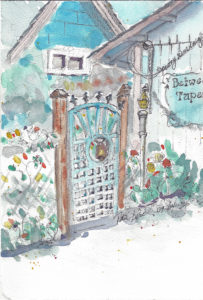
Between &; Etc, gate to the studio by Patti Kirsch
1st Announcement–
Between & Etc. will now be open on Wednesdays (unless, I am traveling). My hopes are that tapestry weavers will drop in to talk
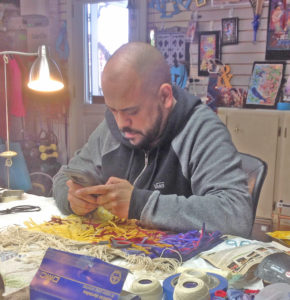
Peter Rocci-Wednesday @Between & Etc.
about tapestry and tapestry technique and/or bring a loom and just sit and weave. Wednesday’s from 10 AM to 9 pm.
2nd Announcement
I have created a face book group called Small Format Tapestry- a place of our own
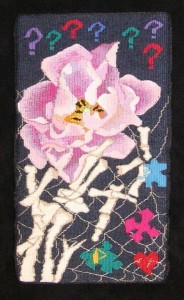
What Spider could have taught Icarus
I am hoping that it will become a discussion group about all things small format tapestry, places to show SF, exhibits of small format tapestry, discussion of technical information pertaining to SF tap. And/or just a place to show what SF tapestry weavers are doing. Size for discussion and showing work is anything less than 15 inches by 15 inches. Http://www.facebook.com/groups/260926634316763
I have 3 tapestry questions that were asked of me since my last post by workshop students.
So, ANYWAY, I have three choices, write about warping with a continuous warp, or write about optical blending in tapestry. Decided that since it was going to be another rainy grey day, I opted for colour. Next time the
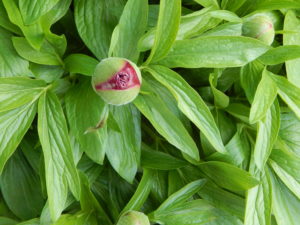
Almost ready
continuous warping which is partially covered in my blog on these pages of May 8, 2014, but is more specific to Mirrix looms.
There will also be an article in the Colour issue of Tapestry Topics article on Dot’s for the next issue of Tapestry topics. More information on colour and Tapestry can be found on the ATA Educational articles that I wrote a few years back. Todd-Hooker, Kathe, “The Simple, Short Version of Colour Movement in Tapestry”
First Things First
There is no right or wrong way to choose colours, or how you work with those technical and or traditional elements-or non-traditional elements- no one way. there are no tapestry police. Choosing colours is a very personal decision. there is no right or wrong. It’s more about does it work for you! No ones going to take your loom away if you choose a different way to treat your colour weaving choices. It just is what it is…AND, there are choices- lots of choices.
So I am choosing to discuss the way I weave tapestry and discussing optical blending based more or less on Gobelin Tapestry-French Tapestry–with other things thrown- Such as Itten (German Bauhaus) use of colour contrast and weaving from the front(British- started by William Morris).. . Most so very long ago I have about forgotten where and who they came from. I prefer to wrap my wefts on bobbins so I can control the flow, smoothness and twist of the weft as it leaves the bobbin and lands on the fell line to create it’s
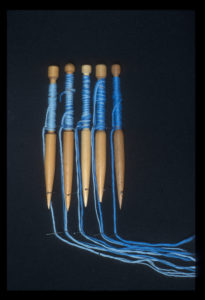
Mélange Colour fade or similar colours wrapped on Gobelin style bobbins, but usually I prefer Swedish style bobbins
dots of colour. It just is what it is…
I weave in two different ways that use the exact same techniques-Small format/Small scale and large format/large scale.
Where they differ is in scale and format. These differences dictate the materials I use in my tapestry for me. Large format large scale is 10-12 epi, warp is cotton seine twine, usually 12/6 and occasionally 12/9 depending on the hand of the fabric or “drabability”I wish to achieve. My weft bundle usually consist of 4-6 threads of wool. When I weave small format-most of the time)small scale it is 22epi. I have pretty much switched my warp from dual duty craft thread for the warp because It’s getting hard to get. Its twist and composition has changed so it’s “stretchier”-still usable but not my favourite anymore. I am now in the last 2 or 3 weavings using cotton seine twine 20/6. My weft bundles are composed of sewing thread 4-5 threads or embroidery floss that contains 6 strands that are fairly easy to separate and recombine. Multiples also allows me to change the reflective quality by adding silks, rayons that reflect light in a different way than wool and cotton.
First question–(optically blending colours)
Why use multiple wefts in my weft bundle?
Tapestry is all about that dot of colour and where it crosses the weft and the four adjacent dots surrounding the dot. With multiple wefts on the bobbin I can usually choose in some way which of those dots that are created when it crosses the warp is more dominate and create even smaller dots of colours that will blend optically
I can create more colours by blending strands of different hues together which allows the eye at a distance to optically blend into more and lively colour blends as the dots of colour react to their adjacent dots of colour. This was first described by Michel Chevreul in His book The Principles of Harmony and Contrast of colours: and their Applications to the Arts published in 1855 and later translated into English. The coloured dots play off each other to create mixed colours that don’t grey out from a distance.
I know! I know!
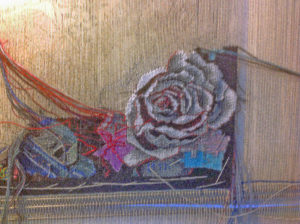
Detail Chaos
Check out the Artists such as Paul Signac and Seurat, Van Gogh’s “man in a felt hat” and, of course, Delacroix.
They are painters. But, the ideas were actually put forth by A Gobelin dyer by a Gobelin dyer by the name of Michael E. Chevreul in 1855. His ideas heavily influenced the movements of pointillism and Divisionism.
Optical blending is created by dots of colour and how those colours react to adjacent dots of colours. Mixing wefts together creates dots of colour that are easily controllable in tapestry weaving because of weft blending and the fact that it is usually meant to be viewed from a distance.
Bridge colours between hatches will also blend together to create a third colour an optical blend of the two or more hatches. The fastest way to research this go to Wikipedia. It has short easy definitions that link to the various components of Pointillism and Divisionism that so relate to tapestry.
Second question-Spinning weft colours
Why not spin the colours together to blend instead of using multiple weft strands?
Generally, the more intimate the colour blend- spinning or twisting the wefts tightly by spinning- or smaller the
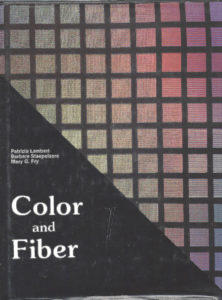
As far as I am concerned this is one of the best books written on Colour theory for fibers.
scale of the twisted dots the more likely the eye from a distance will grey the colours
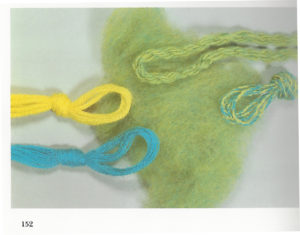
“Factors that influence hue in any optical blend” from Colour and Fiber
optically. To optically blend colours together there must be a seeable dot of colour for the eye to blend. Spinning the colour blends in the yarn creates dots and colour blends that are difficult to see.
I am sort of borrowing a pix page 156 to illustrate this point about spinning wefts and what happens to it’s ability to optical blend. Notice how the spun wefts grey out. While the other wefts mixed together of o the two colours will blend optically from a distance in a different colour mix.
Third Question-Weft Techniques
What can I do with these weft techniques?
Chine’s-combining high contrast to create colour blends. One needs to be aware that some colours create greys when woven together and optically blend in the distance. This is especially true of compliments such as green and red, blue and orange, yellow and blue. Actually, any colour that is directly across from another colour on the
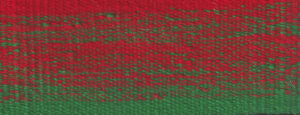
Colour fade or Chene through red and green complements will optically blend to a very lively grey
colour wheel.
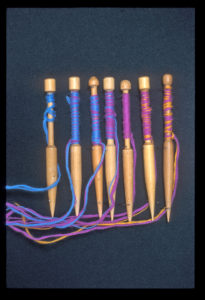
Chene Gobelin bobbins wound to create a Chene effect
You can also create a type of simultaneous contrast by blending wefts that are across the colour wheel
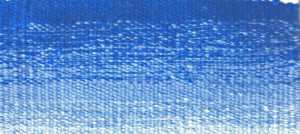
Colours or Mélange are usually similar in value or hue.
from each

Mélange Colour fade or similar colours
other but, slight to the right or left of each other wants to correct the colour so it is straight across the colour wheel. To much of this type of weft blend can really make the eye uneasy in an optical blend.
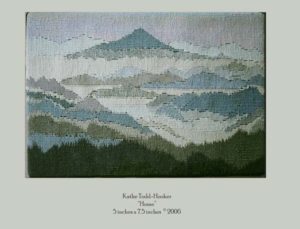
This tapestry that is very difficult to photograph. Mostly because the foggy sky’s greys are mixtures of same value complements that optically blend into greys from a distance
Mottling Twisting the weft bundle.
You can control the weft bundle dots of colour or density by twisting the weft
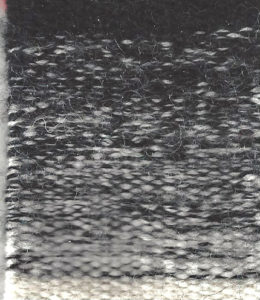
Notice the density of the white and black dots. They change with the tighter or loosing the twist on the weft bundle as it is lays along the fell line.
bundle tight and or looser to create a d=more density to a weft blend.
Colour fades, and mottling when moving the fade up the weft can also make a colour fade look less linear and less laid in by changing the ratio of the dots of colour along the feel line. Check out the difference in the look of the colour fading in the examples of the Chene and Mélanges and the mottled example
Bridge colours other types of optical blending

bridge colours using hatches can also optically blend into a third colour from a distance
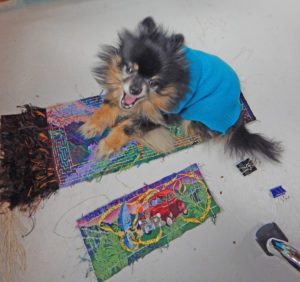
bye for now! I think I have written enuff for a while. Chene needs a walk! Please feel free to make comments and leave messages or start a discussion in the comment section of this post. I’d love to hear from you all! kathe
Bridge colours optical blends are important because one can create changes in the bridge colour by changing the size of the weft bundle. notice the series of lines or combs where the two colours come to together in the center of the sample. By changing the density of the lines one can from a distance create an optical blend that will light and or darken given areas. In this sample I ended with a weft bundle that contained 5 weft threads, but ended with 5 threads in the weft bundle.

Hatches to move colour up and over while using changes in the colours of the weft bundle-Also attached is chene in orange and blue. This sample has been turned on the side so the warps move from side to side. Notice the reversal of lights and darks.